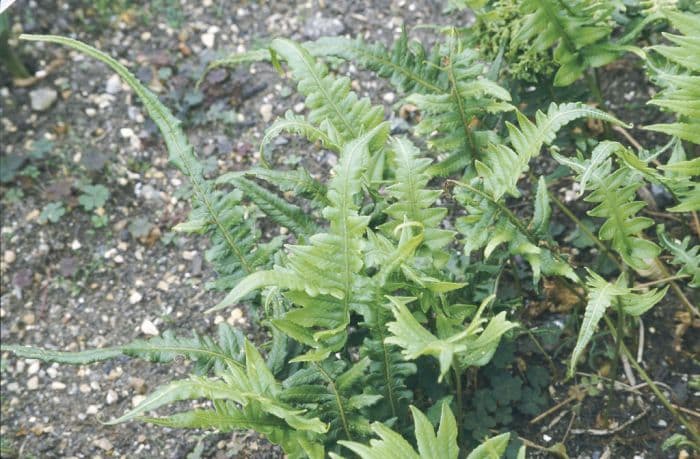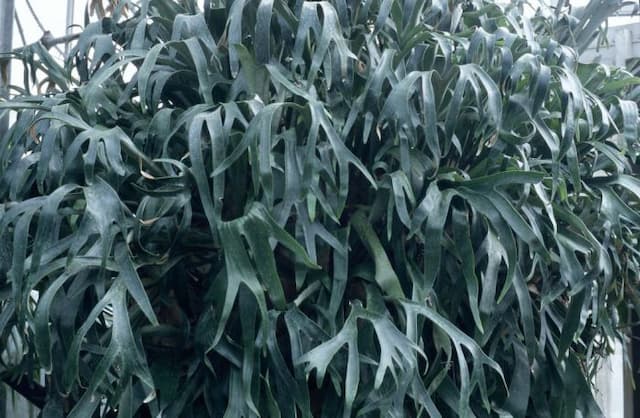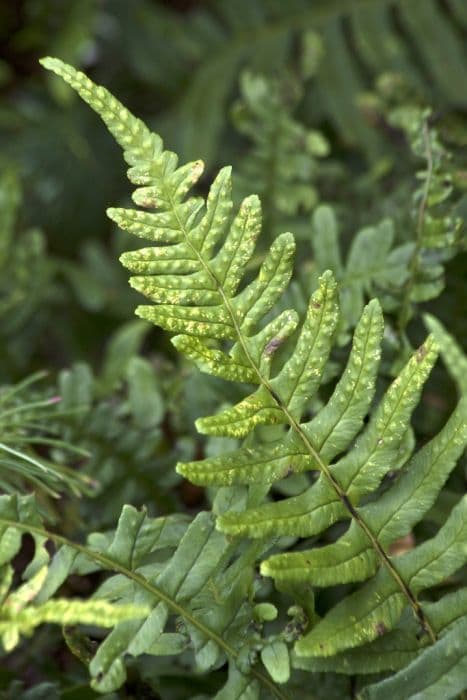Licorice Fern Polypodium glycyrrhiza 'Longicaudatum'

ABOUT
Polypodium glycyrrhiza 'Longicaudatum', commonly known as the licorice fern, is a perennial plant known for its unique and attractive foliage. This fern has long, arching fronds that are divided into smaller, leaflet-like segments, giving it a feathery appearance. The color of the fronds is typically a lush green, which can brighten up shaded areas where it prefers to grow. Its texture is somewhat leathery, and the leaflets are arranged alternately on each side of the central stem (rachis), with a slight overlap. The underside of the fronds is where the reproductive structures, called sori, are found. These appear as small, rounded dots and are used for spore production. The edges of the leaflets may sometimes be curled under, partially concealing the sori. As for its rhizomes from which the fronds emerge, they are creeping and may possess a sweet flavor reminiscent of licorice, hence the common name. The overall appearance of the licorice fern is one that blends well into woodland settings or rock gardens, lending a natural and woodsy aesthetic wherever it is grown.
About this plant
 Names
NamesFamily
Polypodiaceae
Synonyms
Licorice Fern, Sweet Root
Common names
Polypodium glycyrrhiza 'Longicaudatum'.
 Toxicity
ToxicityTo humans
The plant commonly known as licorice fern (Polypodium glycyrrhiza) is not known to be toxic to humans. In fact, parts of this plant have been used traditionally for medicinal purposes due to its natural sweet flavor likened to licorice.
To pets
Licorice fern (Polypodium glycyrrhiza) is also not recognized as a toxic plant to pets. There is no well-documented toxicity associated with pets ingesting this fern, and it is not typically listed as hazardous to dogs, cats, or other domestic animals. However, as with any non-food plant, ingestion of plant material by pets should be monitored, and if you suspect your pet is ill after eating any plant, consult a veterinarian.
 Characteristics
CharacteristicsLife cycle
Perennials
Foliage type
Evergreen
Color of leaves
Green
Height
1-3 feet (0.3-0.9 meters)
Spread
1-3 feet (0.3-0.9 meters)
Plant type
Fern
Hardiness zones
6
Native area
North America
Benefits
 General Benefits
General Benefits- Low Maintenance: The plant is relatively easy to care for, requiring minimal upkeep.
- Shade Tolerant: It can thrive in low-light environments, making it suitable for indoor spaces with limited sunlight.
- Drought Resistant: Once established, it has good tolerance to periods of dryness, reducing the need for frequent watering.
- Decorative Appearance: The unique and elongated fronds of the 'Longicaudatum' variety can provide an attractive aesthetic to gardens or indoor spaces.
- Evergreen: Being an evergreen fern, it retains its foliage all year round, ensuring continuous greenery.
- Soil Erosion Control: With its ability to form dense clumps, it can help stabilize soil and prevent erosion.
- Habitat Support: The plant can offer shelter and food for various insects and wildlife.
 Medical Properties
Medical PropertiesThis plant is not used for medical purposes.
 Air-purifying Qualities
Air-purifying QualitiesThis plant is not specifically known for air purifying qualities.
 Other Uses
Other Uses- Licorice fern roots can be used as a natural toothbrush. The antimicrobial properties of the root can help in maintaining oral hygiene, when chewed or used to brush teeth.
- The fronds of the licorice fern can serve as an addition to floral arrangements, adding a touch of greenery and wild beauty to bouquets.
- Fern collectors may cultivate Licorice fern for its unique long rhizomes as an interesting specimen in fern gardens or terrariums.
- As a natural dye, the Licorice fern can be used to provide a soft green hue to textiles, leveraging the plant's pigments in a sustainable fashion.
- The root of Licorice fern can be used in the crafting of nature-based jewelry, where dried and treated sections of the root are incorporated into necklaces or earrings.
- Enthusiasts of miniature landscapes or fairy gardens use the small and intricate fern to create a sense of a lush, enchanted forest within their compositions.
- Given the Licorice fern's resilience, it can be used in outdoor educational settings to teach about native plants, plant identification, and ecology.
- The fibers from the rhizome have been used historically to create woven mats and other textiles by indigenous peoples of the Pacific Northwest.
- For natural pest control, some gardeners use ferns like the Licorice fern as a way to deter certain insects, leveraging their natural aroma.
- As an aid in natural composting, the Licorice fern can be included in compost piles to break down and enrich the resulting compost with nutrients.
Interesting Facts
 Feng Shui
Feng ShuiThe Licorice fern is not used in Feng Shui practice.
 Zodiac Sign Compitability
Zodiac Sign CompitabilityThe Licorice fern is not used in astrology practice.
 Plant Symbolism
Plant Symbolism- Licorice Fern - Resilience: Known for its ability to thrive on the trunks and branches of trees in its native environment, the Licorice Fern symbolizes resilience and adaptability in the face of challenging conditions.
- Licorice Fern - Healing: As the root of the Licorice Fern has been traditionally used for its medicinal properties to treat ailments, it represents healing and the nurturing of health.
- Licorice Fern - Sweetness: The name "Licorice" refers to the sweet flavor of the fern's root, which symbolizes the sweetness and pleasure in life, reminding us of the joys to be found in natural simplicity.
 Water
WaterThe Licorice Fern requires consistent moisture and should be watered thoroughly once the top inch of soil feels dry to the touch. Depending on the environment's humidity and temperature, this could generally amount to watering approximately every 7 to 10 days. It is important to use lukewarm water and to avoid waterlogging the soil, which can lead to root rot. Typically, pour around 16 to 24 ounces of water for average-sized pots, ensuring an even distribution across the soil. During the winter months, reduce the frequency of watering since growth slows down and the plant requires less moisture.
 Light
LightLicorice Fern thrives in dappled sunlight to partial shade, mimicking its natural habitat under forest canopies. The best spot for this plant is in a room with bright, indirect light or in a shaded area outdoors where it can receive some morning light but be protected from the harsh afternoon sun. Keep it away from direct sunlight, as too much can scorch its leaves and diminish its health.
 Temperature
TemperatureLicorice Fern prefers a temperature range between 50°F to 70°F for optimal growth. It can survive minimum temperatures down to about 30°F, but frost is not its friend. Ensure to keep it away from cold drafts and sudden temperature changes. The ideal temperature conditions are a stable environment where sudden fluctuations are minimal, maintaining a comfortable room temperature that replicates its natural cool and humid forest conditions.
 Pruning
PruningLicorice Fern may require occasional pruning to remove dead or damaged fronds and to maintain its shape. It is best to prune in the spring before new growth begins. Using clean, sharp scissors or shears, cut back the fronds close to the base, avoiding any new shoots. Pruning once a year is often enough to keep the plant healthy and looking tidy.
 Cleaning
CleaningAs needed
 Soil
SoilThe Licorice Fern thrives in a soil mix consisting of equal parts peat, coarse sand, and leaf mold or finely shredded pine bark. This combination ensures good drainage and a slightly acidic to neutral pH environment (pH 5.5–7.0) which the Licorice Fern prefers.
 Repotting
RepottingLicorice Ferns do not need frequent repotting; they can be repotted every 2 to 3 years. It is best to repot in the spring when the plant shows signs of becoming root-bound or the soil appears depleted.
 Humidity & Misting
Humidity & MistingLicorice Ferns prefer high humidity levels, ideally around 70%-80%. Maintaining consistent humidity is crucial for the health and growth of the fern.
 Suitable locations
Suitable locationsIndoor
Place in bright, indirect light and maintain high humidity for Licorice Fern.
Outdoor
Protect from direct sun, ensure moist soil, and shelter from harsh winds for Licorice Fern.
Hardiness zone
5-9 USDA
 Life cycle
Life cyclePolypodium glycyrrhiza 'Longicaudatum', commonly known as licorice fern, begins its life cycle as a spore, which is produced in sporangia on the undersides of mature fern fronds. When conditions are optimal with sufficient moisture, these spores germinate to form a tiny, heart-shaped gametophyte (prothallus), which is rarely seen. The gametophyte houses both male and female reproductive organs (antheridia and archegonia, respectively) and, upon fertilization, gives rise to a new sporophyte. The sporophyte stage is the dominant and visible phase, where the plant develops rhizomes, fronds, and eventually matures to produce sporangia, completing the cycle. Licorice ferns require a moist environment throughout their life cycle, often growing on mossy branches or rocks in shaded, forested areas. The plant is perennial, and under favorable conditions, it will continue to grow and propagate through spores, expanding its presence in its habitat.
 Propogation
PropogationPropogation time
Spring-Early Summer
Polypodium glycyrrhiza 'Longicaudatum', commonly known as licorice fern, can be propagated effectively through spore collection and sowing, although this is not the most popular method. The most widely used method for propagating the licorice fern is division, which is best done in the early spring or fall. To propagate licorice ferns by division, carefully dig up an established fern, making sure to keep a good amount of roots attached to each division. Once you have divided the fern into smaller clumps, replant each piece at the same soil depth it was at originally, and water thoroughly. Ensure each division has adequate space for growth when situating it in a new location, as crowding can limit the plant's development. This method leverages the fern's natural tendency to spread and can quickly produce new plants that will mature and fill out the planting area over time.

